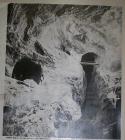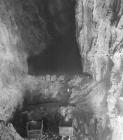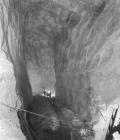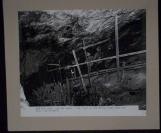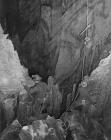1
A video of the Malagash Salt Mine1941
Malagash, Nova Scotia, Canada
 Credits:
Credits:National Film Board of Canada
2
This short video on the Malagash Salt Mine was made by the National Film Board of Canada in 1941.4
DESCRIPTION OF THE MALAGASH SALT MINEThe Malagash Mine was an intrically folded but seldom broken mass 300 feet thick. In the 300 feet there were three seams (beds) of relatively high purity which conformed one with the other. Two were competant, the Lucas and MacKay, and the other incompetent (Chambers); that is it and its adjoining beds fractured.
One should realize that salt is a plastic the flows under pressue. It will fill any cavity it may encounter under the earth's crust.
Under the provinces of Ontario and Saskatchewan the evaporite beds are undisturbed, that is they are almost perfectly flat lying and just as they were laid down when ancient seas from which they came, evaporated. They are almost as flat as ice on a lake.
However, this is not the case in the Maritimes. When the forces in the earth's crust that caused the Appalachian Mountains to form exerted pressure, all of the many salt deposits began to flow and were highly contorted - and adjoining evaporite beds which were more brittle, chiefly gypsum (plaster), fractured and became dispersed in the relatively plastic salt. At both Malagash and Pugwash gypsum or anhydrite (calcium sulphate) is the chief impurity.
The bed that extends to depth in Malagash, the Lucas Seam, could be likened to a crumpled sheet of writing paper, folded and bent but never broken. The thickness of the sheet would represent a salt bed thickness averaging about 12 feet and the sheet of paper, would represent a dimension, one half mile on each side, the whole dipping to the South at an average of 40 degrees.
Actually the dip varied from a flat of 24 degrees to an extreme of 120 degrees when it turned under itself in a 200 foot plunge, that made spectacular scenery after the salt was extracted.
6
Slope No. 4 level of the Malagash Salt Mine.8
Kenny Wilson talking about working in the Malagash Salt Mine in the early 1950's with Canadian Industries Limited, to change the way the salt was dynamited.So how was life in Malagash at the time? You were 16 you started you had just started at the salt mine. Obviously the population was a lot bigger, what was it like back then?
Well if we had a bad snow storm in the wintertime and it lasted a week, it wouldn't affect us at all because we had grocery stores. In the salt mine right down here we had a grocery store, a pool room, which is like a convenience store they call it today. We had a tea room where the ladies could go and have tea, a post office, a community hall and we had movies once a week. Pretty well self sufficient.
So that was all a result of the salt mine was it?
Basically yes.
So after you did the sewing of the bags do you remember what job you did after that? That was 1951 you said?
In 1952 when I got laid off my job in the wintertime, about February, I went to school in Sydney and took an auto body course. That Summer when I came back, finished it, I already knew who to weld and I knew how to paint, so I was only there four months instead of six, and I got called back to work at the mine. And I thought what's going on, this time of year we don't usually get called back to work. But they decided that I would be working with CIL (Canadian Industries Limited); and they were going to try, Canadian Industries Limited were going to try and go underground and change the way that we dynamited the salt, out of the face or the wall. So they put me with them and I worked there for about three months, I think it was roughly. Determining how to change the way we did it to get the salt out of the wall in bigger chunks, was what the idea was; because we couldn't sell the fine, couldn't sell all the fine salt. So underground they used a big undercutter which was like a power saw with a twelve foot boom on it, and that cuts the bottom of the wall, and that's what makes the floor, or whatever you want to call it, nice and smooth underground. And then they drill every four feet they drill a hole about twelve feet deep in a sequence, and then you put dynamite in the holes with timers on them. And the first row of dynamite on the bottom goes out the first and that leaves room for the rest to explode to move out. And we had to change the way we did it. Instead of putting so much dynamite in and such a snap to the salt to break it all up, we started using tubes of salt made out of dynamite paper.
So how did that work exactly?
That helped, you got quite bigger chunks of salt.
So was the dynamite wrapped in some kind of paper?
Well the sticks of dynamite are always wrapped in paper, just like wax paper, they were about a foot long. And I should tell you that we had a special belt for carrying these salt sticks that I had. I used to make them up they looked exactly like a stick of dynamite because I was using the papers. And I had eight or ten of those on my belt one day, when I went to go underground I remembered that I had to get something out of the storeroom, and I walked in with all these sticks that looked like dynamite, the storekeeper took a weave one way and a weave the other and he shot out the back door and that was it, he left the scene altogether he thought I was going to blow the place up!
So did you make a special belt to carry those?
CIL had them; they were using them for carrying dynamite.
So you said it was better when they wrapped the paper around, how did that, it didn't break off such chunks?
Instead of filling the drill hole full of dynamite, we'd put a stick of dynamite, a stick of salt, a stick of dynamite, and a stick of salt and that would cut it in half. And then we changed that to one stick of dynamite, two sticks of salt, different measurements in the hole to see what we could do to make it work. And after a while we got it to work.
And that was pretty successful?
Yes.
10
MINING THE SALT IN MALAGASHThe Malagash miners recovered the salt by the open stope overhand method - a shaft driven down and stopes run out from the sides, with vertical inclined 'raises' run up from the bottom of the shaft to the floor of the stope. As the salt was drilled and blasted away from the face, the miners would slush it down via the raise to the skip at the bottom of the shaft, whence it was hoisted to the surface.
At the stope face the miners, most of whom were local men, operated their pneumatic drills from "benches" - three or four feet wide ledges cut across the great wall of salt and rocks. The stopes - some were vast enough to hold a cathedral - formed huge glittering caverns where the white and grey walls echoed back the roar of the drills.
On the surface, the skip was dumped onto two picking tables where the rock salt was hand-sorted and fed into the preliminary crusher with a 30 inch by 30 inch opening. From here the crushed salt went to the first set of sizing screens. Various grades of salt moved onto the bagging hoppers or the bulk hoppers, and so to waiting railway cars.
12
Stairs and ladders were as if from a story book. From &-A level to 11 level, one continous stair had 220 steps, each step made of a piece of 2x6 - 30 inches long. Another stair had 167 steps. One ladder reached almost vertically 200 feet.A second way in and out of the new slope of the Mine was commenced 900 feet west of the Shaft by engineer James Anderson in 1941. It connected with No. 3 & 5 levels by 1943, and in 1948 it was sunk to join 7-A level.
After 1949 this "New Slope" was used to hoist salt to the pilot plant building where a small rock salt mill had been built.
14
Salt was mined from 110 feet below the surface to 1,250 feet below. The travelled distance at an average of about 40 degrees, was over 2,800 feet. Three hoists were used to get the salt to the surface and someone christened the system "A mechanical bucket brigade".Everyone working in the Mine at Malagash became a Mountain Climber. Instead of stairs there were ladders (and they were numerous) in many stopes a 3/4 " rope would be hanging and this rope was the sole means of elevating or lowering oneself. Sneakers or running shoes were excellent for clinging to the steep walls but when hard-toed boots became a safety feature the canvas shoes had to go.
